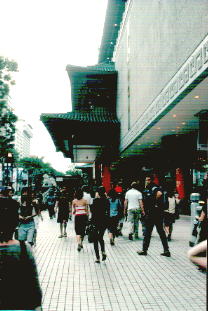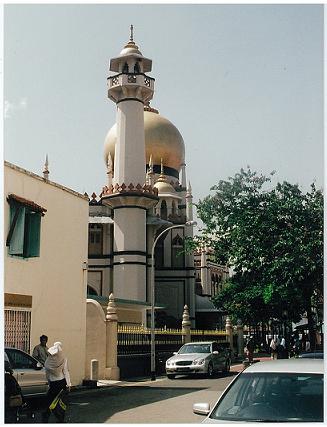Republic of SingaporeSingapore is one of the last city-states -- a single city which is a country unto itself, once a common arrangement in, for example, Classical Greece and the ancient Near East, but no longer. To approach Singapore by sea is to see the advantage of its commanding position at the mouth of the Strait of Malacca -- ships too numerous to count, from all over the world, lie at anchor ouside the harbor, waiting their turn to go in. One can see no end to them, shadowy forms half-visible in the glim in every direction, in addition to those near enough to see clearly. To set the scene for understanding Singapore, by sea is surely the best approach; however, one can always arrive by more conventional routes: by air at Changi International Airport, or by land from Malaysia, over the Johor Causeway. A regular bus route runs between Singapore and Johor, Malaysia.Within Singapore, the public transport system must be one of the most advanced in the world: there is an extensive network of subway/light rail lines, for which one can purchase refillable fare cards resembling credit cards; a mere tap of the card against a sensor at the gate is sufficient -- your credit is read in an instant. The same cards can also be used on the city buses. The taxicabs have not yet adopted this system, but they are equipped with credit-card readers located conveniently next to the meter, and decals on the passenger-side window show at a glance which cards are accepted. (To come from this into, say, the United States is a bit of a shock; "Exact change only!? What is this, the Stone Age?")
|

Everywhere you go in Singapore, you see the Capitalist tradition of Stamford Raffles and the Overseas Chinese going strong. Throughout Southeast Asia, for hundreds of years, cadres of Chinese capitalists have been the economic elite in every country. When the British came to Singapore, it was only natural they and the Chinese would combine forces and build a powerhous commercial city. This grand edifice, which in another era would have been an imperial palace or a great temple, is in fact Tang Plaza, one of the many downtown shopping emporia. Perhaps it may be thought of as a temple of Commerce; indeed, Commerce does seem to have something of the status of a god here. To a Vagabond accustomed to "live simply, that others may simply live," this can make Singapore seem strangely surreal. More surreal still is Sim Lim Square, a towering skyscraper (or so it seems; actually, it is just six floors) inhabited almost exclusively by electronics merchants. Ride the escalators up past floor after floor of televisions, digital camcorders, computer parts, 100-packs of blank CDs, GPS transceivers, fish finders, just about any electronic gadget one can think of.
Outside the central business district, Singapore has its own beauty, which can be enjoyed to a great extent simply by riding a commuter train and looking out the window. One of the first things one notices in this way is the diversity of people. Notices inside the trains are in four languages: English, Malay, Chinese, and Tamil. (The Chinese can be difficult to read, because for some reason, this bastion of Capitalism uses the Maoist "simplified" characters.) The variety of faces and costume reflects this variety of languages. This is the home of actress/pop singer Fann Wong, who sings in Chinese. One can, in various places, see Chinese temples, Hindu temples, Christian churches, Muslim mosques. Everybody seems to speak English, however.
Clearly, Singapore is a futuristic (i.e., forward-looking) city. And so we might now mention the futuristic-looking building in this picture, a very distinct landmark, known as the Concourse. Although the Concourse looks interesting from a distance, do not waste time going up close -- the shopping mall on the ground floor is even less interesting than most (literally nothing there worth mentioning), and above is only an office building much like any other. No, we mention the Concourse as a landmark -- just a few blocks to the southwest of it is Arab Street.
|
 Also in Arab Street is the Sultan Mosque, largest in the city, but by no means the only one. If it so happens that you pass by here as prayers are letting out, you will see throngs of people in light-colored garments. I looked carefully, but it seemed all I saw were men. Presumably women pray elsewhere.
Also in Arab Street is the Sultan Mosque, largest in the city, but by no means the only one. If it so happens that you pass by here as prayers are letting out, you will see throngs of people in light-colored garments. I looked carefully, but it seemed all I saw were men. Presumably women pray elsewhere.
I was surprised that this mostly-Chinese city has a Chinatown. This is a relic of the British days, when the ethnic groups were separated into distinct enclaves; after independence, enlightened government policies involving housing quotas eliminated racial and ethnic tensions within a decade. Walk south from the Chinatown subway station, and you will find Tea Chapter Trading, a Chinese teahouse. Upstairs is the tea drinking area, with intimate little nooks decorated in spare, Chinese style, where small groups of friends can enjoy tea and conversation. The Chinese tea ceremony is worth experiencing; be sure to select a tea with an aroma you enjoy, because the ceremony centers on enjoying the changing aroma of tea as it goes from hot to cool, and the change again from aroma to taste. The tea house can also be a romantic setting for other sorts of conversation. Downstairs is the sales area, with a selection of Chinese tea sets and associated paraphernalia. (Goodness, I just can't stop speaking in terms of shopping; Singapore does that to a person -- it became one of the economic tigers through commerce, after all.) The travel guide mentioned a Taiwanese tea house also, but I was unable to find it. There are also Chinese apothecaries in this area, for those who prefer Chinese traditional medicine; the apothecary will formulate your medicine from the array of ingredients in his wall of little drawers.
Another ethnic enclave is Little India, with buildings painted in gaudy rainbow colours. Here, too are mosques, a reminder that India is not monolithically Hindu. Note the difference between this mosque (left picture) and the Sultan Mosque: whereas the Sultan Mosque has gilded onion domes and windows of onion dome-like shape, this mosque in Little India has square windows, and is overall brighter in colour, with a very different style of ornamentation. On one bloc of shopfronts, presumably with dwellings above, each unit bore the Muslim crescent-and-star emblem on semicircles above each window, as seen in the right picture. In addition to the expected Indian restaurants and sellers of Hindu paraphernalia (icons, incense, ghee, etc.), there are various purveyors of audio CDs: music in Hindi, Tamil, and other languages; from Hindu chants, to Tamil Christian songs, to themes from Tamil cinema. The Indian Classical Music Store is of particular note; here, one can find sitars, drums, and bamboo flutes in various sizes, including children's sizes; sheet music and instructional books (some in English, some in Tamil); and recordings of sitar music. As in Arab Street, one can also find silk merchants here. So far, I have avoided mentioning the overtly touristy spots, but I cannot pass over the Singapore Night Safari. This is one of the most enlightened zoos I have ever seen: there are extensive free-range areas, where animals roam in natural settings; and by only opening at night, it allows people to see nocturnal animals actively moving about instead of just sleeping. This was the first place I ever saw such rare oddities as the fishing-cat, the binturong, the red panda, the chevrotain, and a whole herd of babirusa. There were a few no-shows, e.g. the giant anteater, but then, that is true of any trip to any zoo. Further, the trained-animal show, "Creatures of the Night" displays an unusually strong environmental consciousness (Hint: if you are afraid of snakes, avoid the first three or four rows in the center bloc). On the other hand, there are ethical questions as to whether animals ought to be trained for human entertainment anyway.
At the center of Singapore Island is a complex of nature reserves, which share a common border with the zoo and night safari, and together fill the center of the island and surround the city reserviors. All are strictly protected. And although there are mature rain forests in the heart of Singapore Island, and a burgeoning city surrounds them, no timber harvest takes place here. Singapore Science Center has published a series of guidebooks (in English) on various aspects of nature in Singapore. The centerpiece of the reserves is Bukit Timah Reserve, Singapore's highest hill, and part of its core of tropical rain forest reserves (there is also a Bukit Timah Road, so if you are coming here by taxi, tell the driver, "Bukit Timah Hill," to avoid confusion -- an irony of Singapore's adopting English is that no one notices the redundancy: "bukit" is Malay for "hill", so "Bukit Timah Hill" literally means Tin Hill Hill). This eco-consciousness might at first seem surprising in such an urbanized and commerce-driven place; but remember, Singapore is confined to a small island. It has no room to spread, no hinterland to buffer itself. It has therefore been forced to become conscious of its limited natural resources, and to adopt strict conservation policies. Singapore has gained notoriety in the West for its draconian law enforcement, although, in fairness, it must be pointed out that beatings with the rotan are a long-standing Malay custom, and still practiced in Malaysia and Indonesia as well as Singapore. More frequently, penalties take the form of fines, the amounts of which are often posted on signs in relevant places. |

Case in point: these monkeys (longtailed macacques, Macaca fascicularis) live near the base of Bukit Timah. Although they are thoroughly habituated to the presence of humans, and people gather around to look at them, no one feeds them, because the signs clearly post the amount of the fine for doing so. Singapore is the exception to the stereotype of tropical rain forest regions: normally, we constantly hear about the great number of undiscovered species, the need to catalogue them before they disappear, etc.; but this is not so in Singapore. In Singapore's rain forests, most of the species are known, and Singapore Science Center has even been able to publish data about which plants are common, rare, endangered, and locally extinct. This is one of the advantages to being a rich country: Singapore has the time and resources to have thoroughly explored even its old-growth rainforests, and determined its conservation strategy. We may hope other tropical nations will be able to do this before too much is lost. As an anti-consumerist, I do find this a troubling irony: how much of the nature in other countries had to be despoiled to provide Singapore with the financial resources to protect its own remaining forests? The flashy electronics in Sim Lim Tower are made of copper, silicon, plastic, and many other materials, all of which were mined somewhere, refined and processed somewhere, probably not here. In the end, the shimmering mirage of Singapore wavers and fades -- one still cannot have both conservation and high-tech materialism at the same time.
|